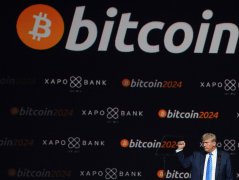Peru hoping to become the 'Singapore of Latin America' on the back of China's new megaport
A drone view shows cranes and containers at the new megaport in Chancay, Peru.
In short:
A new majority Chinese-owned megaport has officially begun operating in Peru.
The port in Chancay will be able to handle the world's biggest ships and it is set to become a major hub for trade between South America and China.
What's next?
For now, the port is undergoing a soft opening, only taking in limited numbers of ships, but soon it is expected to move over 1 million shipping containers a year.
China's $US3.5 billion ($5.3 billion) new megaport in a small city in Peru has officially begun operations this week.
President Xi Jinping virtually launched the port from Peru's capital Lima in a ceremony with Peruvian president Dina Boluarte.
Xi said the port would help "promote connectivity" between South America and China.
"We are witnessing... the birth of a new land-sea channel between Asia and Latin America in the new era," he said
The site is situated around 80 kilometres north of the capital Lima and is expected to become a major hub for trade between South America and China.
Chinese port operator Cosco Shipping has a 60 per cent stake in the facility, and will handle port operations.
Peru's President Dina Boluarte and Chinese President Xi shake hands after virtually inaugurating the megaport.
"With the addition of this port, this part of the Pacific and Peru in particular could become the logistical hub of South America," Gonzalo Rios, deputy general manager of the Peruvian subsidiary of Cosco Shipping said.
The remaining 40 per cent of the port is held by Peruvian miner Volcan, which is controlled by Glencore.
Professor James Laurenceson, director of Australia-China Relations Institute (ACRI) said it should come as "no shock" that China has built a port in the region.
"The fact is six of the 10 biggest ports in the world are in China, and many more are China-owned," he said.
"China are very good at building ports"
How big is the port?
It's big, but not the biggest.
The complex covers an area of 992 hectares and features a 1.8km long underground tunnel.
The start of the 1.8km long tunnel at Chancay.
Chancay's maximum depth is 17.8 metres, which is two metres deeper than nearby Callao port in Lima.
That depth also means it is capable of handling the world's biggest container ships.
The port is on par with the deepest ports in South America but some way off the deepest ports in the world.
Yangshan Port in Shanghai is one of the deepest in the world, with a depth of 27 metres. It is also the world's busiest port, able to move 49 million TEU each year.
TEU is twenty-foot equivalent units which is another term for a standard shipping container. The measurement refers to how many shipping containers are transported through the port.
The new Chancay port is forecasted to move over 1 million TEU in its first year of operations.
Initially the port will utilise ships carrying up to 14,000 containers, and then move to larger vessels holding up to 24,000 containers.
The Peruvian government estimates the port will create over 8,000 jobs in the next 10 years.
The 'Singapore of Latin America'
Chancay is expected to be a major hub for imports of Asian electronics, textiles and other consumer goods.
Minerals are set to be the main export, including lithium — a metal used in mobile phone and laptop batteries — from Chile and copper from both Chile and Peru.
Bilateral trade between the Asian giant and Peru stood at nearly $US36 billion in 2023, making Peru China's fourth-largest Latin American trading partner.
Peruvian Transport Minister Raul Perez said the goal for Peru is to "become the Singapore of Latin America".
Work gets underway at the megaport.
"We will have direct routes to Asia, in particular to China, which will reduce (shipping time) by 10, 15, even 20 days, depending on the route," he said.
He added that it would compete with Mexico's Port of Manzanillo and eventually Long Beach in California.
Chancay port will also serve Chile, Colombia and Ecuador, among other South American countries, allowing them to skirt ports in Mexico and the United States for trade with Asia.
Belt and Road Initiative
The port is the latest addition to the vast collection of railways, highways and other infrastructure projects built under China's massive Belt and Road Initiative.
Launched in 2013, the program initially focused on better connecting China with Europe, Africa and the rest of Asia but has since expanded to include South America.
Chancay, a fishing town of around 50,000 inhabitants, was chosen for its strategic location in the heart of South America.
President Xi believes it is a key moment in the Belt and Road Initiative in South America.
“The completion of the Chancay port, a landmark project of the belt and road cooperation between our two countries,” he said.
A total of 22 Latin American and Caribbean countries have have now joined the Belt and Road Initiative by signing memoranda with China.
Peru have taken the cooperation a step further and signed a new optimised free trade agreement with China.
The agreement was originally signed in 2009, the updated version is expected to boost commerce by at least 50 per cent between the two countries.
Four other countries in the region have a free trade agreement with China — Chile, Costa Rica, Nicaragua and Ecuador.
Impact on Australia
The opening of the Chancay port will help reduce shipping times and costs to Australia according to Peru's trade commissioner to Australia, Soledad Campos de Parry.
Mining and critical minerals were major areas where investment could flow, she said, adding it was easier to lean into it because of the free trade agreement between Australia and Peru.
"Especially in the mining supply services for the sector because we have...a tax incentive," she said.
"We have a lot of expertise as well."
Trade Minister Don Farrell welcomes more trade with Peru.
Trade Minister Don Farrell has said the government welcomes any expansion in the relationship with Peru.
"They are part of our diversification strategy," he said.
"So what does that mean? Well, we want to sell more into China, but we want to sell more to the rest of the world."
Professor Laurenceson of the ACRI believes that the new port will contribute to greater trade opportunities with South America, but also with China.
"The Indo-Pacific region is one that is in overwhelming agreement that more trade with China is a good thing," he said.
By:ABC(责任编辑:admin)
下一篇:What time is the Mike Tyson and Jake Paul fight? How can I watch it in Australia?
 Socceroos rescue a point
Socceroos rescue a point  Wallabies thrash Wales 52
Wallabies thrash Wales 52 Jake Paul beats Mike Tyso
Jake Paul beats Mike Tyso Live updates: England vs
Live updates: England vs  US election 2024: Donald
US election 2024: Donald  US election live: Kamala
US election live: Kamala
- ·Brazil police formally accuse former pr
- ·Donald Trump's choice for US attor
- ·Japanese state sued in lawsuit seeking
- ·Jury finds MMA star Conor McGregor sexu
- ·Laken Riley's murder became a MAGA
- ·The celebrity look-alike craze is about
- ·Five remaining Bali Nine members could
- ·North Korea's latest weapon agains
- ·Brazil police formally accuse former pres
- ·Donald Trump's choice for US attorne
- ·Japanese state sued in lawsuit seeking to
- ·Jury finds MMA star Conor McGregor sexual
- ·Laken Riley's murder became a MAGA r
- ·The celebrity look-alike craze is about m
- ·Five remaining Bali Nine members could so
- ·North Korea's latest weapon against
- ·Hezbollah says Israel 'cannot impose
- ·Inside the rise of US oligarchs and how i
- ·One of Vietnam's high-profile politi
- ·Shanghai Walmart Attack: A Man Randomly S
- ·South Korean police officers jailed over
- ·Cambodia publicly shames maid deported af
- ·North Korea to use all forces including n
- ·Philippines condemns China attack of Viet
- ·US adds 2 more Chinese companies to Uyghu
- ·North Korean defector steals South Korean
- ·Malaysia deports Cambodian worker for cal
- ·Rebels battle for Myanmar junta’s weste

